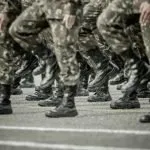It’s a story that grabs your attention. An Army veteran, someone who served this country, found himself temporarily detained by active-duty Marines on American soil. This wasn’t overseas in a combat zone; this was in Los Angeles. This incident involving a veteran detained by Marines immediately set off alarm bells for many people, especially within the military and veteran community. It makes you wonder what’s happening when military personnel appear to take on roles usually handled by civilian law enforcement. We need to look closely at this situation involving a veteran detained by Marines because it brings up some very serious questions about rights and roles.
Table Of Contents:
- The Day Everything Changed for Marcos Leao
- A Veteran Detained by Marines: Crossing Legal Lines?
- Military and Law Enforcement: A Blurring Partnership
- Why Were Troops in Los Angeles?
- On the Ground: A Different Story for Some Troops
- The Southern Border: Military’s Deepening Immigration Role
- Long-Term Worries: The Cost of Blurring Lines
- Conclusion
The Day Everything Changed for Marcos Leao
Marcos Leao, a 27-year-old Army veteran, was simply trying to manage his affairs. He needed to pick up some paperwork from the Department of Veterans Affairs. Like many of us, he was listening to music on his headphones, likely not expecting his day to take such a dramatic turn. He took a shortcut near the Wilshire Federal Building, slipping past some police tape. He stated he quickly complied when a service member told him to go back behind the tape, an interaction he initially perceived as routine.
After showing his ID at the VA building, he believed the matter was resolved. But then, the situation escalated rapidly. According to Military.com, he heard shouting and soon found himself on the ground with Marines zip-tying his wrists. Leao, who served as a combat engineer in Iraq, was held for nearly two hours before Los Angeles police took him into custody. He described the entire experience as “ridiculous” and a “big miscommunication,” highlighting the confusion surrounding the events.
Thankfully, the police did not charge him with any crime and subsequently let him go. Leao mentioned that because of his military background and understanding of military life, he knew how to handle the situation calmly. But he worried about how someone without his experience might react, saying they would “probably freak the heck out.” This concern underscores the potential for severe distress when civilians encounter military personnel in law enforcement scenarios.
A Veteran Detained by Marines: Crossing Legal Lines?
This event with the veteran detained by Marines has many legal experts engaged in serious discussion. A key point of debate is the Posse Comitatus Act. This law generally prohibits the use of U.S. military forces, including the Marine Corps and Air Force, to perform domestic civilian law enforcement duties. While the Pentagon suggested the detention was lawful, several experts have raised significant doubts. The core issue revolves around whether the Marines were protecting property or actually enforcing laws, a distinction critical to understanding the legality of their actions.
Dan Maurer, a law professor at Ohio Northern University with a background in the Army Judge Advocate General Corps, explained some of the intricate details. He said if Marines zip-tied someone because they perceived an immediate threat, such as the individual reaching for a weapon, that action might be viewed as force protection. However, if the zip-ties were used to keep someone subdued for questioning, it begins to look much more like law enforcement activity, akin to a temporary arrest. The interpretation often hinges on the perceived intent and the immediate circumstances.
In Marcos Leao’s case, he was unarmed and held for approximately two hours until Los Angeles police arrived, which is a considerable length of time. Maurer noted that tools common on a battlefield, like zip-ties, don’t necessarily feel like law enforcement tools to soldiers, but to the public, they appear functionally identical to handcuffs. This difference in perception can lead to public outcry and legal challenges, even reaching the appeals court or, in some cases, the Supreme Court.
Carrie Lee, a senior fellow at the German Marshall Fund, offered a more direct assessment. She stated, “When the Marines detain the U.S. Army veteran trying to get into the federal building with zip ties, that’s law enforcement.” Lindsay Cohn, a professor at the Navy’s War College, speaking in her personal capacity, pointed out that placing military personnel in situations where they work closely with federal agents like ICE almost guarantees they might engage in actions that resemble law enforcement. These experts generally agree that the public doesn’t always discern the fine legal distinctions officials might make between terms like ‘detention’ and ‘arrest.’ The overall impression created is that troops were policing American streets, a role traditionally reserved for civilian law enforcement.
Military and Law Enforcement: A Blurring Partnership
The incident with Marcos Leao isn’t occurring in isolation. It seems to be part of a broader pattern where the lines between military duties and domestic law enforcement responsibilities are becoming increasingly indistinct. Under the administration of President Donald Trump, there has been a noticeable increase in military involvement in tasks traditionally handled by civilian agencies. We’ve seen thousands of troops, including National Guard troops, deployed to the southern border. Thousands more have been sent to American cities in response to protests, sometimes even around Juneteenth celebrations.
This closer relationship extends to agencies like the Department of Homeland Security (DHS), Immigration and Customs Enforcement (ICE), and Customs and Border Protection (CBP). There have been pilot programs where Marines work with ICE at base gates, ostensibly to stop foreign nationals from entering. The Pentagon has even encouraged service members to seek job training opportunities with DHS and Border Patrol while still in uniform, potentially as part of their career advice or veteran employment project transition plans. Such programs might use targeted advertising to attract service members.
It was reported that 700 personnel were being sent to help ICE with administrative tasks. Defense Secretary Pete Hegseth appeared to endorse this type of activity, even posting a photo online of troops with ICE agents during an immigration raid, captioning it with the Army motto, “This We’ll Defend.” This growing collaboration, particularly involving Marines who detain individuals, makes it harder to distinguish where national defense ends and civilian law enforcement begins. Concerns about personal data handling and privacy policy also arise in these joint operations.
Why Were Troops in Los Angeles?
So, what led to National Guardsmen and Marines from various units, including those typically associated with the Coast Guard or even Space Force discussions regarding national assets, being in Los Angeles? The White House ordered their deployment amidst protests. These protests were related to ICE immigration raids occurring in the city. Initially, 4,000 guard troops were activated by President Donald Trump, with 2,000 reportedly heading to the greater LA area. Specifically, about 200 Marines from the 2nd Battalion, 7th Marines, were sent to the Wilshire Federal Building, where Leao was detained. Their stated mission was to provide protection for federal property.
The White House, through spokesperson Abigail Jackson, asserted that the troops were needed to address “lawless chaos” in LA. She also hinted that similar deployments could happen in other cities if their leaders permitted what she characterized as “violence to occur against federal law enforcement.” This federal response came despite objections from California Governor Gavin Newsom. The plan was for the California Guard and Marines to be stationed in the LA area for 60 days. This significant military presence in a major American city, particularly at a federal building also housing Veterans Affairs offices, is certainly a sight that makes people ask difficult questions about federal overreach and the role of the military.
The deployment raised concerns about the optics and the message being sent. Using military personnel, including the National Guard, for such purposes can be a contentious issue. The decision by President Donald Trump to deploy these forces highlighted the administration’s willingness to use the military in domestic situations, prompting widespread debate on social media and in news alerts. Many wondered if this was a necessary step or a political statement. The Wilshire Federal building became a focal point not just for VA services but also for this unfolding drama.
On the Ground: A Different Story for Some Troops
It’s one thing to hear about thousands of troops being deployed to a city like Los Angeles. It’s another to understand what they are actually doing day-to-day. For some California National Guard members involved in the LA mission, it felt less like a critical operation and more like an “extended vacation.” One soldier, speaking anonymously, mentioned spending a significant portion of his time playing video games, perhaps even a military trivia game to pass the hours. He was not tasked with directly assisting law enforcement or engaging with protestors.
A California Guard official noted that many units were conducting their own training, some of it unrelated to the immediate mission, or even catching up on college work online. This might involve navigating VA ebenefits portals or looking up military pay scales. While some personnel were undoubtedly busy, many were apparently not directly involved in the main events. This situation raises questions about how personnel are utilized during such deployments and the actual need for such large numbers. The visual of guard troops on city streets can be impactful, regardless of their specific duties.
Sometimes, the National Guard seems to serve as a visible symbol, a show of force or resolve. It can be a way for political leaders to appear decisive or score political points. For instance, Texas Governor Greg Abbott announced a large mobilization of Guardsmen before some anti-Trump demonstrations, but those troops were not heavily utilized in direct confrontation. These deployments still come at a cost, both financially and in terms of readiness for other duties, and can affect the morale of the National Guard troops involved. They might also impact future veteran job prospects if their specialized military skills aren’t maintained.
The Southern Border: Military’s Deepening Immigration Role
The situation in Los Angeles isn’t the only place we see the military taking on roles that approach immigration enforcement. There are around 7,000 active-duty troops supporting Joint Task Force-Southern Border. This is part of a broader effort to increase military presence along the U.S.-Mexico border, an effort often framed by political rhetoric about an “invasion” of migrants and accompanied by plans for large-scale deportation efforts. This expanded role for the military, including Army and Marine Corps units, is a significant shift.
A notable development is the creation of new military zones from federally controlled border land. These zones are now linked to nearby military bases like Fort Huachuca in Arizona and Fort Bliss in Texas. This administrative setup allows service members, working under Border Patrol supervision, to approach individuals on this land much as they would on a military base. Even though it’s vast desert, it’s being treated differently under these new designations. This again demonstrates a clear shift towards more military involvement in immigration matters, which have historically been a civilian law enforcement function. The handling of personal data of apprehended individuals also becomes a concern here.
The tasks assigned to troops can vary, from engineering support and transportation to surveillance and administrative duties. While direct apprehension of migrants is generally still left to Border Patrol, the lines can blur when military personnel are in close proximity and providing direct support to law enforcement operations. This continued military presence raises questions about the long-term strategy and the impact on the communities living near the border. It also brings up the efficiency of using highly trained military personnel for tasks that civilian agencies could potentially handle.
| Aspect | Military Personnel | Civilian Law Enforcement |
|---|---|---|
| Primary Mission | National defense, combat operations, protecting national interests abroad. | Maintain public order, enforce laws, protect life and property domestically. |
| Legal Authority (Domestic) | Limited by Posse Comitatus Act; generally cannot directly enforce civilian laws. Exceptions exist (e.g., National Guard in state status, specific Congressional authorizations). | Full authority to enforce laws, make arrests, conduct investigations within their jurisdiction. |
| Training Focus | Warfighting, use of overwhelming force, combat tactics, military fitness. | De-escalation, community policing, individual rights, rules of evidence, use of minimum necessary force. |
| Equipment | Military-grade weapons, vehicles, and equipment designed for combat. | Sidearms, less-lethal options, standard police vehicles, investigative tools. |
| Accountability | Uniform Code of Military Justice (UCMJ), military chain of command. | Civilian courts, internal affairs, civilian oversight bodies. |
Long-Term Worries: The Cost of Blurring Lines
Experts warn that these trends of military involvement in domestic issues could have serious long-term consequences. Lindsay Cohn pointed out some immediate harms, such as to troop readiness. When military members are used for these domestic missions, they are not training for their primary warfighting roles. This diversion of resources and focus can affect their preparedness for other critical global missions, impacting overall military life and operational capabilities. Morale can also take a significant hit, especially for members of the Army, Marine Corps, Air Force, and even the Coast Guard when called upon for such duties.
Cohn suggested these are not the kinds of missions that military personnel usually want to do; they can be psychologically and emotionally taxing, potentially impacting veteran health long term. Another major concern is the potential damage to military recruiting, especially among vet friendly employers who value specific military experiences. After years of struggling to meet recruiting goals, the services had recently seen some improvements. Cohn stated the LA mission involving the veteran detained by Marines was very unlikely to be a “recruiting boon” and had a higher chance of becoming a “recruiting problem.” Parents might hesitate to encourage their children to enlist if they perceive the military is being used as a domestic police force.
Dan Maurer also commented on the administration’s approach under President Donald Trump. He suggested that they valued the appearance of strength and power, perhaps prioritizing a show of force. This focus, he argued, might come at the expense of healthy civil-military relationships, constitutional principles, and due process. When the military gets too involved in domestic politics or law enforcement, it can erode public trust and its nonpartisan standing. These are precious commodities that are hard to rebuild once lost, potentially affecting everything from VA loans processing trust to confidence in national security leadership at the White House.
The impact on veterans themselves is also a critical consideration. Many veterans joined the military to defend the country against foreign adversaries, not to engage in actions against fellow citizens. Witnessing or hearing about incidents like the veteran detained by Marines can be disheartening and confusing. It might affect their access to or perception of veteran health care and other services provided by Veterans Affairs. Finding a good veteran job or transitioning to civilian life can be challenging enough without adding concerns about the changing role of the institution they served. Many resources exist for veteran employment, such as the veteran employment project and platforms for saved jobs and cover letters. Even engaging in leisure activities like a military trivia game or finding Veterans Day restaurant discounts can be a part of community building, but serious incidents overshadow these aspects of veteran life.
Furthermore, the use of social media in disseminating information about such events is powerful. Videos and accounts can spread rapidly, often without full context, shaping public perception quickly. While platforms may have settings for color transparency or captions settings on video play features, the core message received by the public can be hard to control. This impacts not only the military’s image but also how civilian law enforcement is perceived when seen working alongside or being supplanted by military personnel. Even something as mundane as a checkbox label label on a government form or a simple label label on a file can become part of a larger bureaucratic process that feels impersonal and detached from the human impact of these policies. Efforts to provide news alerts and play video segments for transparency are important.
Discussion forums and military podcasts might explore these issues, offering career advice or dissecting military history related to domestic deployments. The government’s privacy policy regarding data collected during such operations also comes under scrutiny. It’s a complex landscape, where a single incident like the one at the Wilshire Federal building can have far-reaching implications, sparking debates that reach all the way to the Supreme Court. The search for vet friendly employers and support for veteran health are ongoing needs, regardless of these broader geopolitical or domestic shifts. Accessing benefits via VA ebenefits, understanding military pay, and planning for the future are constant concerns for service members and veterans alike. Friendly employers who understand military experience are highly sought after. Events around Veterans Day often feature discounts and opportunities to honor service, a stark contrast to the tensions raised by domestic deployments.
Conclusion
The case of the veteran detained by Marines in Los Angeles is more than just a single, isolated event; it is a significant incident that reflects broader, and frankly, troubling trends regarding the use of military personnel on American soil. It shines a bright light on the increasing involvement of the armed forces, including the Marine Corps and National Guard troops, in domestic situations. When you see soldiers in city streets near a federal building doing things that look like police work, it changes how people view the military and its role in a democratic society. This specific instance at the Wilshire Federal building has sparked considerable debate.
For veterans, current service members, and their families, these are not small matters; they touch upon the core values and expectations associated with military service and military life. The clear separation between military and civilian law enforcement, largely codified by the Posse Comitatus Act, is there for well-established reasons. When those lines get fuzzy, it affects everyone’s rights, the public’s trust in institutions, and potentially even veteran job prospects or access to veteran health care. This erosion of distinct roles can lead to confusion and concern among the populace.
The discussion about the veteran detained by Marines, specifically Marcos Leao, forces us to think hard about the military’s appropriate role here at home and what we want that to look like in the future. It compels a re-examination of policies set by figures like President Donald Trump and implemented by departments, and how these affect everything from personal data security to the atmosphere around Juneteenth celebrations or Veterans Day. The goal should be to maintain a strong military focused on its primary missions while safeguarding the civilian nature of law enforcement in our communities. Events like these, highlighted through social media and news alerts, serve as critical reminders of the delicate balance required.




Leave a Reply